The Unrecognized Aussie Coat Colors
by C.A. Sharp
First published in Double Helix Network News, Winter 1996, Rev. April 2013
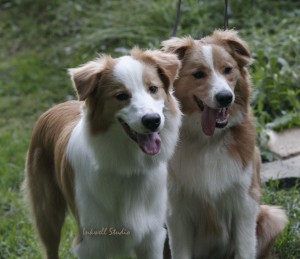
Watching an Australian Shepherd litter whelped is like opening a series of surprise packages. Will the next pup be black? Red? Will it be merle or have showy white markings? Will its tan markings shine like fresh-minted pennies? But sometimes the surprise is bigger than the breeder bargains for. There, among the tiny squirming bodies—black and blue merle, red merle and red—is color that clashes with our notions of what an Aussie should look like.
Aussies are a young breed. The Australian Shepherd Club of America, the original breed club, formed in 1957. Most regional clubs have been around for a much shorter time than that. The most distant dogs in the pedigrees don’t always have registration numbers and somewhere along the line, usually in dogs born before 1970, the lines peter out altogether. In those days before registration became standard, Aussies came in all the colors we know today, plus a few. These other colors were not common even then, but their genes still lurk in the Aussie gene pool. Every once in a while those genes align.
In the years before registries, more than a few breeds likely contributed to what is today the Australian Shepherd. At the time, most dogs belonged to ranchers and farmers who were only concerned that pups would prove useful. Thus two proven workers would be mated in hopes of producing more of the same, without much concern for whether their parents were purebreds or of the same breed and certainly not for what color they were. In those days before neutering became common there were also probably more than a few “oops” litters and if the pups proved useful, they were kept.
It is safe to say that while the bulk of the ancestry stems from “collie type” breeds, some imported with sheep from Australia (hence the breed name) and including the smooth-faced variety of the Pyrenean Shepherd, just about every herding breed and probably a few hunting breeds were among the contributors to today’s Aussie. This contributed to our varied set of acceptable—and unacceptable—colors. The Farmer’s Dog, a classic work on the Border Collie, observes that all of the acceptable Australian Shepherd colors plus the most common unacceptable ones have occurred in that breed. English Shepherds come in the same group of colors, except for merle.
Off-colored pups are becoming more rare, but every breeder needs to be aware of the colors most likely to occur and the genes that produce them.
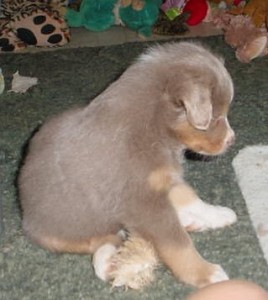
Dilute
One of the two most common unacceptable colors is dilute, usually caused by a recessive mutation of a gene called melanophilan (MLPH.) Dog breeders have log referred to this gene as “D” after the pioneering coat color research of Clarence Little in the 1930s. This type of dilute should not be confused with “dilution spots,” which are isolated off-color areas in an otherwise normally colored merle coat. In dilutes, the coat color, whether black, liver or merle patterned, is lightened by the action of a pair of the recessive version of MLPH. Areas that would otherwise be black appear slate blue, blue areas are a significantly paler shade than would occur without the dilute genes. Liver will become “Isabella,” a buffy-orange shade. The dilution will not affect tan (copper) trim.
The result can be quite striking—a blue coat trimmed with white and bright tan or a merle combining slate blue with silver. Dilutes of black and blue merle are easy to spot. Not so with liver. Due to the variability of pigment depth in our “red dogs” and especially the merles, a dilute may appear “washed-out” but not evoke further comment or the understanding of what it is.
Dilute is also seen—and is acceptable—in Great Danes, Weimeraners, Neapolitan Mastiffs and Dobermans, among other breeds. It is sometimes associated with skin problems. This does not appear to be an issue in Aussies.
Since dilute recessive, both parents must carry the gene for puppies to be dilute in color. There is a DNA test available so the carriers could be bred to clear-tested mates and not produce more dilute puppies. Offspring that are to be used for breeding would need to be tested to determine their MLPH status.
There are dilute Aussies that do not have the MLPH mutation. And some dilute Aussies darken as they age until the coat color is indistinguishable from normal black or liver coats when the dog is adult. These non-MLPH forms also appear to be recessive but at this writing the genetic cause is unknown.
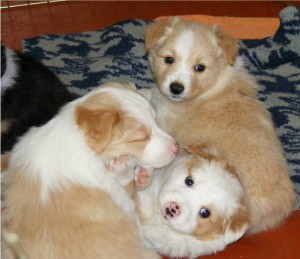
Yellow and Reds with Black Noses
The other most common unacceptable color, the result of another diluting gene called melanocortin receptor 1 (MC1r), or “E” in Little’s nomenclature. Also due to a recessive version of the gene, it acts on the base color, whether black or liver, merle or not, causing a color ranging from pale yellow to deep chestnut. Aussie breeders have sometimes called the color “peach.” If the color is at the chestnut end of the scale and the dog also has at least one gene for black, the result will be a “red with a black nose.” These dogs are not truly “red” (liver.)
If the dog is merle, the pattern may be faintly visible when it is young but tends to fade to an even color in the adult coat. Tan markings will not be apparent, though white will. If the dog would otherwise have been liver or red merle, the nose, eye rims, lips and pads will be liver.
Sable
This color is most commonly associated with Collies. It may have come to Aussies from that breed or the Shetland Sheepdog, but Border Collies and English Shepherds will also occur in this color. While once seen fairly frequently, it is now extremely rare if not absent. Aussies described as “sable” today are almost always actually E-locus recessives.
The gene that causes sable color is agouti signal peptide (ASIP), or “A” per Little. The dominant version of this gene cases sable. There are three other versions in the following order of dominance, the wild type (“wolf sable”), one that causes tan trim, and one for no tan. Most Aussies have tan trim and therefore cannot carry sable. A truly sable Aussie would have to have at least one parent who was sable or carried a version of yet another gene (beta-defensin103 or “K”) that causes o tan trim. While the dominant no-tan/no sable) version of K could be responsible for a few sable Aussies, they would also have to have the recessive version of that gene that would allow sable (and tan) along with the version of ASIP that causes sable. In a predominantly tan-trim breed this makes true sable extremely likely to occur.
When a sable individual is also a merle, the result is a “sable merle.” The color is often muddy and unattractive. For this reason Collie and Sheltie breeders tend to keep merle and sable lines separate. In some individuals, the merle pattern may be so indistinct the observer will not know the dog is merle.
Saddle Pattern
A color pattern common in German Shepherd Dogs and universal in Airedale Terriers, the saddle pattern features a blanket of full pigment over the back with tan hair ranging from pale beige to copper-red over the rest of the body. They may have white markings. The color of the saddle will reveal the dog’s genotype as regards black/liver and merle/solid.
The genetics of this color pattern are still unclear. It is a modification of tan pointing and involves more than one gene. However, it is clear that for a dog to have it, it must have at least one parent that is sable, yellow or saddle pattern. This is not a pattern that is going to occur in a litter from Aussies whose color meets the breed standard.
Brindle
Brindle is a lacy pattern of one color over another. Brindling is usually arranged in irregular stripes extending from the dorsal line on a forward slant. It is often seen in Greyhounds and Boxers, as well as a number of other breeds. Brindle is caused by beta-defensin 103 (K) that is recessive to the no-tan/sable version and dominant to a version that would allow tan/sable.
The pattern is easily distinguished on a slick-coated dog but may be less obvious on coated dogs like Aussies, as the longer hair would obscure the striping and blend the colors.
The color of the stripes an Aussie could vary, depending upon whether the dog has genes for black or red, merle or not. The brindle stripes could also be dilute in the unlikely circumstance than an Aussie was also homozygous for the dilute gene. The rest of the color will be beige to deep red. The brindle dog may have white markings, but not tan.
Like sable, a full-body (less white markings) brindle is unlikely because tan trim is so common and for the same reasons. However, brindle is expressed anywhere the coat is tan, so the tan points might be brindled and a dog carrying a single copy of the brindle gene could have brindled tan. This last might be difficult to distinguish from the blending of tan and the base coat color which occurs frequently in Aussies.
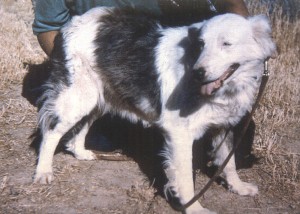
Excessive White
Most Aussie breeders learn early on that breeding merle to merle can result in defective pups, most of which will have excessive white per the breed standard. Merle is our breed’s signature color. In view of this the framers of the ancestor of all current breed standards wanted to discourage people from breeding merle to merle or breeding animals with a lot of white trim which might be double merles. With a certain amount of tinkering, largely catering to the show ring fashion for full white trim, these provisions have remained in the standards in use today.
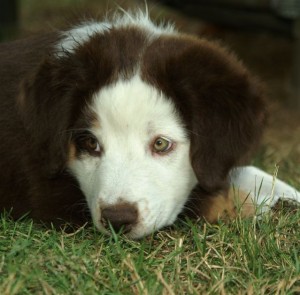
However, doubling-up on merle is not the only road to excess white. There are multiple genes for white trim. One produces the “irish” pattern common to collie-type breeds including the Aussie, with no white being dominant. With another, typical of Boxers, no white is again dominant and mostly white is recessive, while dogs with one copy of each version of the gene are marked in a pattern very similar to “irish.” There are also an unknown number of modifiers which increase or decrease the amount of white seen on the dog but essentially coats with less white are dominant to those with more.
Aussies clearly have the collie-type white spotting. Given that mostly white and piebald puppies which are clearly not double merles do crop up with some frequency, it is very possible we may have the Boxer-type marking also though with less frequency because of the strong selection against excess white.
Details of white markings (half- or fully white heads, white up along the stifles, “body splotches,” etc.) are the result of modifiers. Clearly they are hereditary, with some dogs tending to produce them frequently.
There has long been a myth circulating that more white automatically means more problems. Interestingly, the amount of white even in homozygous merles does not correlate directly to severity of defects. However, dogs with white on or around the ears have some risk of being deaf in one or both ears. Pink skin on noses, the top of the muzzle, on eye rims and other exposed areas of skin are subject to sunburn and have a potential to develop skin cancer.
What’s a breeder to do?
Except as noted above, there is nothing wrong with any of these colors except that the breed standard says Aussies shouldn’t look like that. Otherwise, they are healthy, normal dogs with all the intelligence and talent they would have had if they had been an acceptable color. Such pups certainly should not be used for breeding, but shunning all their kin is over-kill.
Most of these colors are recessives, so both parents will have contributed. If there is a DNA test available, use it on related breeding stock. Do not repeat the breeding or breed first-step relatives (parents, and full or half siblings) of an improperly colored dog close on the pedigrees of either parent or other dogs known to have a family history of the unwanted color. Purchasers of the normally colored ups should be made aware of their potential for carrying unwanted color genes. Beyond that, the breeder can go forth with his program and, we hope, clash no more.
